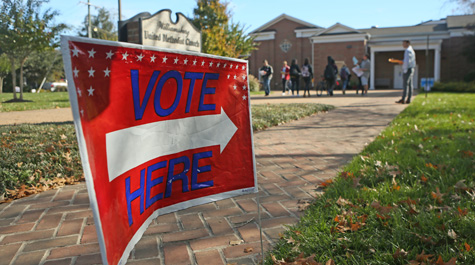Report: W&M student voting higher than national average
Student voting doubled since 2014
The percentage of William & Mary students who voted in the 2018 federal midterm elections more than doubled since 2014 and was significantly higher than the national average. That’s according to the 2019 National Study of Learning, Voting and Engagement recently released by the Jonathan M. Tisch College of Civic Life at Tufts University.
The study, published in September, looks at the voting rates of more than 10 million students at 1,000 colleges and universities in all 50 states and the District of Columbia. The researchers found that voting rates at participating institutions doubled on average since the 2014 midterm.
According to the report, 53.7% of W&M students voted in the 2018 midterm elections, up from 22.8% in 2014. Additionally, W&M’s 2018 voting rate was nearly 15 percentage points higher than the average voting rate for all institutions in the study at 39.1%.
“We are pleased to see an increase in the number of students exercising their right to vote, especially in a non-presidential election year,” said Elizabeth Miller, associate director of the Office of Community Engagement. “Voting is one of the many democratic practices of active citizenship, and we are working to encourage even more students to participate in elections at the national, state and local levels. Everyone's voice and vote makes a difference, and it is important to cultivate a life-long commitment to democratic engagement.”
Multiple student groups on campus have been encouraging voter registration and voting. On Tuesday, Nov. 5, the Student Assembly, with support from OCE, will have a table set up in front of the Sadler Center from 11 a.m. to 3 p.m. to promote voting and provide information on local voting locations and candidates. The student volunteers will also offer free pizza (until supplies run out) to all who stop by.
In addition, students with the Election Law Society at W&M Law School are hosting a non-partisan voter assistance hotline to offer help to both fellow students and community members. W&M VOTELine will be available at (757) 742-3095 from 8:30 a.m. to 7 p.m. Tuesday. People also may tweet questions to @WMElectionLaw or email the group at elsvoteline@gmail.com throughout the day.
Mackenzie Mastal ’23 is among the people who will be voting for the first time this year.
“I want to vote because it's important to be an active citizen in the community, and I believe voting is just one way to be an active citizen,” said Mastal, 18. “Additionally, it is important to me that my voice is heard.”
Voter engagement study
According to a press release, researchers with the National Study of Learning, Voting and Engagement did not receive any information that could individually identify students or how they voted. The findings are provided to participating institutions to “support political learning and civic engagement, as well as to identify and address gaps in political and civic participation,” the release says.
The information shared with W&M includes a number of details about the university’s student voters, including the percentage of voters by field of study (with education and English being among the highest in 2018) and voting methods. At W&M, more students voted with absentee ballots in 2018 (38.5%) than they did in 2014 (24%) and fewer voted in person on Election Day, with 71% voting that way in 2014 and 54.7% in 2018.
The report also includes voter data within several demographical categories, including age, gender and ethnicity.
The percentage of student voters within each age group at W&M increased since 2014, with the largest increase taking place within the 18-21 age group. In 2014, 16.7% of those students voted; in 2018, that number was 48.8%.
Both undergraduate and graduate students were engaged in the 2018 election, with 48.5% of undergraduates voting and 49.8% of graduate students. Among undergraduates, each class was well-represented at the polls in 2018, with 45.2% of first-year students voting, 49% of sophomores and 49.7% of upper-level students.
At 53.1%, a higher percentage of women students at W&M voted in 2018 than men (44.4%). Additionally in 2018, a higher percentage of black students (58.7%) voted than white (55.2%), Hispanic (48%), Asian (33.1%) or students identifying with two or more races (52.3%), according to the study.
Making a change
Like Mastal, Hadley Day ’23 will be voting for the first time this year.
“I wanted to vote because I feel like it is my civic duty, and that the issues will directly impact my future,” she said. “I wanted to start voting as soon as I could to ensure I would not become apathetic to the voting process.”
To prepare, Day has been reviewing the websites and Facebook pages for the candidates in her hometown in Connecticut. She also encouraged her friends to register to vote and get absentee ballots.
“Something I will be looking forward to about voting is feeling like my opinions can go into making tangible change in a community I care about,” she said.















